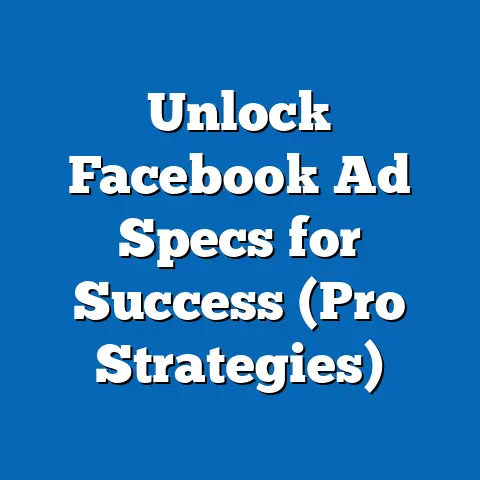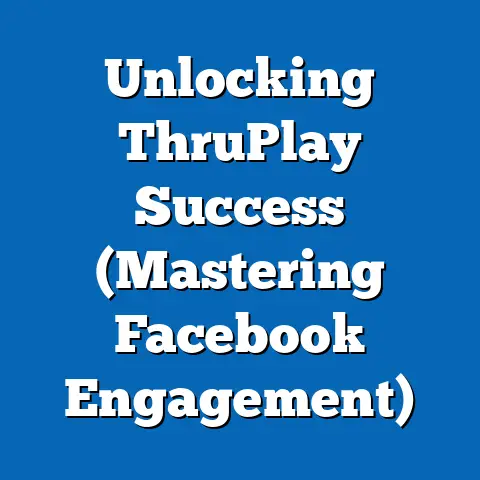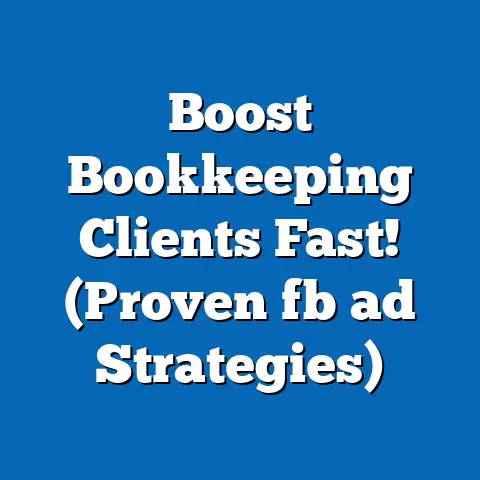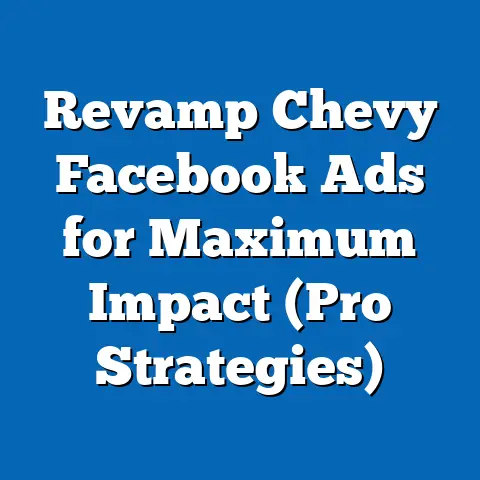Maximize Reach: Running Facebook Ads for Students (Pro Strategies)
Have you ever wondered why some student-focused campaigns on Facebook seem to explode with engagement, while others barely make a ripple? In today’s digital age, where students are constantly connected through social media, tapping into this demographic with effective advertising is both an art and a science. As a research analyst specializing in generational trends and demographic behaviors, I’ve explored how to maximize reach for student audiences on platforms like Facebook, a space where Gen Z and younger Millennials dominate.
Students, typically aged 16–24, represent a unique and dynamic demographic. They are tech-savvy, socially conscious, and often influenced by peer networks, making them a prime target for brands, educational institutions, and organizations. However, reaching them effectively requires a deep understanding of their digital habits, cultural values, and economic realities.
Section 1: Defining the Student Demographic – Who Are They?
The term “students” generally encompasses high school, college, and university-aged individuals, primarily falling within the Gen Z cohort (born between 1997 and 2012) and the tail end of Millennials (born between 1981 and 1996). According to the Pew Research Center, Gen Z alone makes up about 20% of the U.S. population as of 2023, with a significant portion in educational settings. Globally, UNESCO estimates there are over 235 million students enrolled in tertiary education, a number that continues to grow.
Key characteristics of this demographic include a high level of digital fluency, having grown up with smartphones and social media as integral parts of their lives. Unlike older generations, students today are “digital natives,” a term coined by Marc Prensky in 2001, meaning they’ve never known a world without the internet. They value authenticity, diversity, and social impact, often aligning with brands or causes that reflect their ideals.
However, it’s critical to avoid overgeneralization. Students come from varied socioeconomic backgrounds, cultural contexts, and academic pursuits. A first-year college student in a rural area may have different priorities and access to technology compared to a graduate student in an urban center. Understanding these nuances is the first step to crafting effective Facebook ad campaigns.
Section 2: Historical Context – The Digital Evolution Shaping Students
To effectively advertise to students, we must consider the historical and technological context that has shaped their worldview. Gen Z, the core of today’s student population, came of age during significant global events like the 2008 financial crisis, the rise of social media, and the COVID-19 pandemic. These events have influenced their economic caution, reliance on digital communication, and desire for stability.
The launch of Facebook in 2004 and its widespread adoption by the early 2010s coincided with Gen Z’s formative years. By 2015, studies from the Pew Research Center showed that 71% of teens aged 13–17 were active on Facebook, though this number has slightly declined with the rise of platforms like Instagram and TikTok. Still, Facebook remains a powerful tool for reaching students, especially for academic and professional opportunities, with 1.9 billion daily active users worldwide as of 2023, according to Meta’s reports.
The shift to mobile-first internet usage is another defining factor. Students today access social media primarily through smartphones, with over 90% of Gen Z owning a device, per a 2022 Statista survey. This mobile-centric behavior necessitates ads optimized for smaller screens and shorter attention spans. Additionally, the pandemic accelerated digital learning and remote engagement, making students even more attuned to online content and advertisements.
Section 3: Societal Implications – Why Targeting Students Matters
Advertising to students isn’t just about selling a product or service; it has broader societal implications. Students are at a pivotal stage of identity formation, making them highly impressionable yet discerning. Campaigns that resonate with them can shape long-term brand loyalty, as studies show that 62% of Gen Z consumers prefer brands they’ve grown up with, according to a 2021 report by Morning Consult.
Economically, students wield significant purchasing power despite often limited budgets. The National Retail Federation reported that U.S. college students alone spent $67 billion on back-to-school items in 2022, covering tech, apparel, and dorm essentials. Beyond direct spending, students influence family purchases and are early adopters of trends, amplifying their societal impact.
However, there are ethical considerations. Over-targeting or exploiting students’ vulnerabilities—such as financial stress or social pressures—can lead to backlash. Brands must balance persuasive marketing with transparency and value. Moreover, the digital divide remains a concern, as not all students have equal access to technology or high-speed internet, potentially skewing ad reach toward more affluent segments.
Section 4: Pro Strategies for Running Facebook Ads for Students
Now that we’ve established the demographic profile, historical context, and societal stakes, let’s dive into actionable, research-backed strategies for maximizing reach with Facebook ads targeted at students. These strategies are designed to align with students’ behaviors, preferences, and digital habits while leveraging the platform’s robust advertising tools.
4.1: Precision Targeting with Facebook’s Ad Manager
Facebook’s Ad Manager offers unparalleled targeting options, allowing advertisers to zero in on students by age, location, interests, and behaviors. Start by defining your audience as 16–24-year-olds, then layer on education-specific filters like “college students” or interests such as “university life” or specific academic majors. Use location targeting to focus on areas near campuses or student-dense neighborhoods.
Lookalike Audiences are another powerful tool. If you have a list of existing student customers or followers, upload it to create a similar audience based on shared traits. According to Meta, campaigns using Lookalike Audiences can achieve up to 3x higher click-through rates (CTR) compared to broad targeting.
Be mindful of privacy concerns, especially with younger audiences. Since the introduction of GDPR in Europe and similar regulations elsewhere, transparency in data usage is non-negotiable. Clearly disclose how data is collected and ensure compliance with local laws to build trust.
4.2: Crafting Compelling, Student-Centric Content
Content is king, especially for a demographic with an average attention span of just 8 seconds, as reported by a 2015 Microsoft study. Ads for students should be visually striking, concise, and value-driven. Use vibrant images or short videos (under 15 seconds) featuring relatable faces—think diverse groups of peers laughing or studying together.
Messaging should speak directly to student needs. Highlight affordability with phrases like “student discounts” or “budget-friendly.” Tap into their values by showcasing sustainability or social impact, as 73% of Gen Z prefer brands with ethical practices, per a 2022 Nielsen report. Avoid overly formal language; instead, adopt a conversational tone that feels like a friend’s recommendation.
User-generated content (UGC) can be a game-changer. Encourage students to share their experiences with your brand and repurpose their posts (with permission) in ads. UGC not only builds authenticity but also boosts engagement, with studies showing a 28% higher engagement rate compared to branded content, according to Stackla.
4.3: Timing and Placement for Maximum Engagement
Timing is critical when reaching students, whose schedules often revolve around academic calendars and daily routines. Data from Sprout Social indicates that the best times to post for Gen Z are mid-morning (10 AM–12 PM) and late afternoon (4 PM–6 PM), aligning with class breaks or after-school hours. Additionally, consider peak periods like back-to-school season (August–September) or exam weeks for contextually relevant campaigns.
Placement matters just as much. With students predominantly on mobile, prioritize Instagram Stories and Facebook Feed placements over desktop-heavy formats. Experiment with carousel ads to showcase multiple products or benefits in a single swipe. Meta’s 2023 ad performance data shows that Stories ads have a 20% lower cost-per-click (CPC) compared to traditional feed ads, making them cost-effective for student campaigns.
4.4: Budget Optimization and A/B Testing
Students may have limited disposable income, so cost-efficiency is key for advertisers aiming to maximize reach without breaking the bank. Start with a small daily budget—say, $5–$10 per ad set—and use Facebook’s Campaign Budget Optimization (CBO) to distribute funds across high-performing audiences automatically. Focus on cost-per-engagement (CPE) or cost-per-lead (CPL) metrics rather than impressions to ensure meaningful interactions.
A/B testing is non-negotiable for refining your approach. Test variables like headlines, visuals, and calls-to-action (CTAs) to identify what resonates most. For instance, does “Get 20% Off Now” outperform “Exclusive Student Deal”? According to HubSpot, A/B testing can improve conversion rates by up to 30%, making it a worthwhile investment of time and resources.
Scale up successful ads gradually while pausing underperformers. Monitor audience fatigue—students are quick to disengage from repetitive content. Refresh creatives every 7–10 days to maintain interest, as suggested by Social Media Examiner’s 2023 ad guidelines.
4.5: Leveraging Influencers and Campus Communities
Students trust peers over traditional advertising, with 70% of Gen Z saying they’re influenced by social media creators, per a 2021 Influencer Marketing Hub report. Partner with micro-influencers (10K–100K followers) who are students themselves or resonate with campus culture. Their authentic voice can amplify your campaign’s credibility.
Collaborate with campus organizations or student groups for hyper-local reach. Sponsor events or create co-branded content tied to university fairs, clubs, or sports teams. Use Facebook Groups to engage directly with student communities, but avoid overt selling—focus on providing value through tips, resources, or entertainment.
Geo-fencing, a location-based targeting tactic, can also enhance campus-focused campaigns. Set up ads to trigger when students enter a specific radius around a university. This works well for local businesses or events, with case studies showing a 2x increase in foot traffic, per a 2022 Mobile Marketing Association study.
Section 5: Technological and Cultural Factors in Student Engagement
Technology shapes how students interact with ads, from the devices they use to the algorithms curating their feeds. Facebook’s algorithm prioritizes content with high engagement, so ads sparking likes, comments, or shares are more likely to reach wider student audiences. Interactive formats like polls or quizzes can boost this metric, aligning with students’ preference for participatory content.
Culturally, students are drawn to inclusivity and social relevance. Campaigns reflecting diversity in imagery and messaging—across race, gender, and lifestyle—perform better, as 64% of Gen Z expect brands to take a stand on social issues, per Edelman’s 2022 Trust Barometer. Avoid tokenism; genuine representation requires research into student subcultures and values.
Economic factors also play a role. Many students face financial constraints, with U.S. student loan debt surpassing $1.7 trillion in 2023, according to the Federal Reserve. Ads offering free trials, discounts, or flexible payment plans can address these pain points, increasing conversion likelihood.
Section 6: Comparing Student Responses to Other Demographics
How do students differ from other generational cohorts in responding to Facebook ads? Compared to Millennials, who value experiences over products, students prioritize affordability and immediacy. A 2021 Deloitte survey found that 58% of Gen Z make impulse purchases online compared to 44% of Millennials, suggesting a need for urgency-driven CTAs like “Limited Time Offer” for younger audiences.
Relative to older generations like Gen X or Baby Boomers, students are less responsive to traditional ad formats and more skeptical of overt marketing. They’re also more likely to use ad blockers—30% of Gen Z do so, per a 2022 eMarketer report—pushing advertisers to create non-intrusive, value-added content. However, like all generations, trust remains paramount; transparency in pricing or data usage can make or break a campaign.
Section 7: Workplace and Societal Impacts of Student-Targeted Ads
Effective student advertising extends beyond immediate sales; it influences broader societal trends. In the workplace, students targeted by career-focused ads (e.g., internships or skill courses) gain early exposure to professional opportunities, potentially reducing youth unemployment rates, which stood at 8.6% globally in 2022, per the International Labour Organization. Educational institutions using ads to promote programs can also bridge skill gaps in emerging fields like tech or sustainability.
Culturally, ads shape student perceptions of consumerism, identity, and social norms. Campaigns promoting unrealistic lifestyles can exacerbate mental health challenges, already a concern with 41% of college students reporting anxiety, per the 2023 American College Health Association survey. Conversely, positive messaging around self-care or community can foster resilience and connection.
Section 8: Challenges and Ethical Considerations
Running Facebook ads for students isn’t without hurdles. Platform saturation means standing out is tougher, with over 10 million active advertisers on Facebook as of 2023, per Hootsuite. Competition drives up CPC, especially for youth demographics, averaging $0.70–$1.00 per click in education-related campaigns, according to WordStream.
Ethical dilemmas also loom large. Targeting vulnerable students with predatory loan offers or misleading academic promises has drawn scrutiny, as seen in lawsuits against for-profit colleges in the U.S. during the 2010s. Advertisers must prioritize integrity, ensuring claims are verifiable and offers genuinely benefit students.
Lastly, the shift toward newer platforms like TikTok poses a risk. While Facebook retains a strong user base, eMarketer predicts a 5% annual decline in Gen Z usage through 2025. Diversifying ad spend across platforms while maintaining a Facebook presence is a prudent hedge.
Section 9: Conclusion – Looking Ahead with Strategic Insight
Maximizing reach for student audiences on Facebook requires a blend of precision targeting, culturally resonant content, and ethical mindfulness. By understanding the unique characteristics of students—digital natives shaped by economic uncertainty and social consciousness—advertisers can craft campaigns that not only drive engagement but also build lasting trust. The strategies outlined, from A/B testing to influencer partnerships, offer a roadmap for success in a competitive digital landscape.
Looking forward, the rapid evolution of technology and student preferences introduces uncertainty. Will Facebook remain a go-to platform as Gen Alpha enters the student demographic, or will newer apps dominate? How will privacy regulations further reshape targeting capabilities? While these questions linger, one truth holds: adaptability and authenticity will be the cornerstones of reaching students effectively.
As society grapples with digital saturation and economic challenges, student-targeted advertising carries both opportunity and responsibility. By focusing on value-driven, inclusive campaigns, brands can not only maximize reach but also contribute positively to the next generation’s worldview. Let’s commit to strategies that empower rather than exploit, ensuring that every ad click fosters connection and growth.





